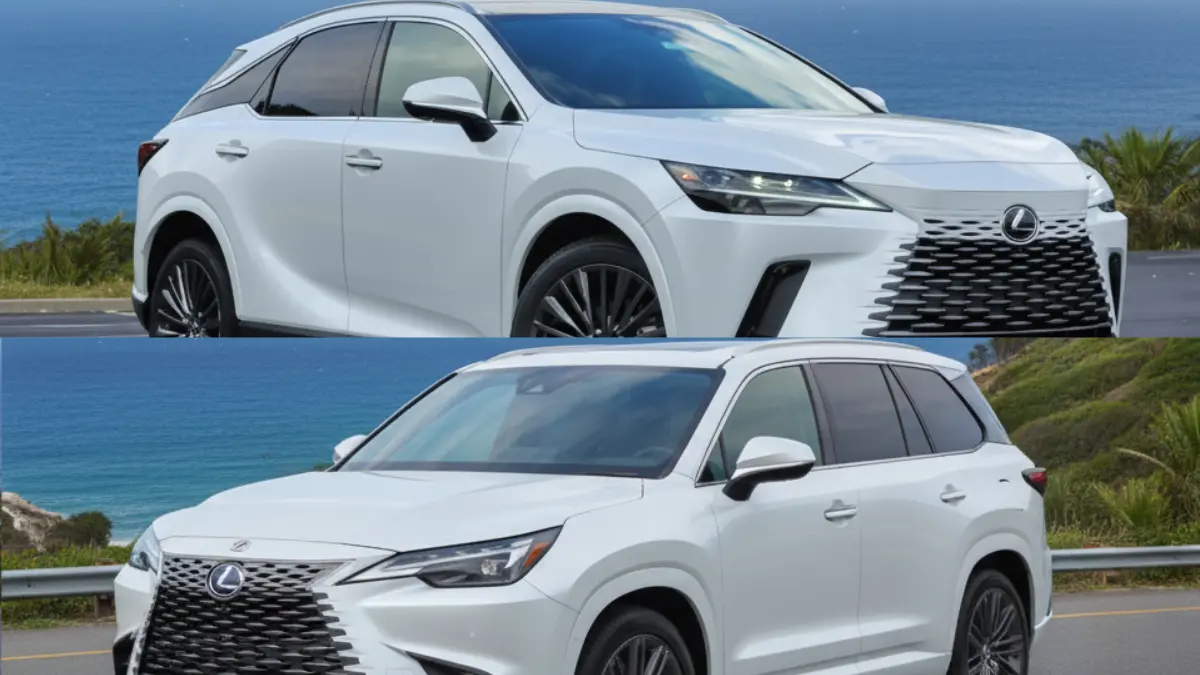2026 Lexus RX 350 vs Lexus TX 350 Comparison: Which Luxury SUV Offers the Better Deal

As the SUV market continues to dominate global car sales, Lexus expands its lineup with seven SUVs and crossovers, including two models that sit closely together in price and purpose, the Lexus RX 350 and the all-new Lexus TX 350. Though they share engines and technology, these two luxury SUVs serve distinct audiences: one prioritizes sportier sophistication, while the other focuses on space and versatility.
Key Specifications
| Specification | Lexus RX 350 | Lexus TX 350 |
|---|---|---|
| Engine | 2.4L Turbo 4-Cylinder | 2.4L Turbo 4-Cylinder |
| Power | 275 hp / 317 lb-ft | 275 hp / 317 lb-ft |
| Transmission | 8-Speed Automatic | 8-Speed Automatic |
| Drivetrain | AWD / FWD | AWD / FWD |
| Towing Capacity | 3,500 lbs | 5,000 lbs |
| Seating | 5 | 6 or 7 |
| Starting Price | ~$55,000 | ~$57,000 |
| Cabin Noise | 53.9 dB | 51.7 dB |
| Warranty | 4yr/50k Basic | 4yr/50k Basic |
Overview: Luxury Meets Practicality
The Lexus RX 350 and Lexus TX 350 both feature Lexus' signature craftsmanship, advanced safety systems, and refined comfort. Yet, their target buyers differ. The RX remains a two-row midsize luxury SUV appealing to those who want agility and high-end design, while the TX steps up as a larger three-row SUV, offering seating for up to seven passengers.
Despite the segment gap, their pricing overlaps significantly, with both starting in the mid-$50,000 range and reaching over $70,000 when fully equipped.
Exterior Design and Dimensions
Both models embody Lexus' evolving design language but with distinct personalities.
- The RX 350 adopts a sportier stance with sharper body lines and the traditional spindle grille, while
- The TX 350 debuts Lexus' "Unified Spindle" front fascia, a sleeker evolution marking a new design era for the brand.
Key exterior highlights include:
- Full LED headlights (RX gets premium triple-beam setup)
- 21-inch wheels on the RX vs. 22-inch wheels on the TX
- Hidden exhaust outlets and LED taillight clusters for both
- Power-folding mirrors with blind-spot monitoring and heating
The TX 350 is a full 10 inches longer than the RX, translating directly into more passenger and cargo space. Despite sharing the same 2.4-liter turbocharged four-cylinder engine, the TX's size enables it to tow up to 5,000 lbs, compared to 3,500 lbs in the RX.
Interior and Comfort
Inside, both cabins reflect Lexus' hallmark of understated luxury, premium materials, excellent fit and finish, and a near-silent ride.
- The RX uses higher-grade materials, featuring more wood trim and layered textures for a more premium aesthetic.
- The TX prioritizes space and practicality, with a larger center console capable of fitting 21 small items (compared to 12 in the RX).
Both SUVs come equipped with:
- Semi-aniline leather seats with heating, ventilation, and memory functions
- 12.3-inch digital instrument cluster and head-up display
- 14-inch infotainment touchscreen with wireless Apple CarPlay and Android Auto
- Mark Levinson 21-speaker audio system
- Digital rearview mirror and panoramic sunroof
The TX 350's three-row layout is its standout feature. It offers a best-in-class third row with impressive legroom and headroom, while the RX remains strictly a two-row SUV.
Rear-seat amenities in both include:
- Rear climate controls, USB-C ports, and window sunshades
- Heated and ventilated rear seats
- Optional captain's chairs in TX; power-adjustable second row in RX
Performance and Driving Experience
Both the Lexus RX 350 and TX 350 are powered by the 2.4-liter turbocharged inline-4 engine producing 275 horsepower and 317 lb-ft of torque, paired with an 8-speed automatic transmission and all-wheel drive on test models.
Performance-wise, the RX feels slightly livelier thanks to its smaller footprint, hitting 0–60 mph about 8% quicker than the TX.
Ride comfort is where both shine, the suspension tuning is plush and absorbent, ideal for long drives. The TX records a cabin noise level of just 51.7 dB, noticeably quieter than the RX's 53.9 dB, offering a near-silent highway experience.
Fuel economy remains similar across both models, though the RX edges out slightly due to its lighter build. Buyers seeking higher efficiency can opt for hybrid and plug-in hybrid variants, available for both SUVs.
Technology and Safety
Lexus ensures top-tier safety and driver assistance across both vehicles.
Standard systems include:
- Blind-spot monitoring
- Adaptive cruise control
- Lane keeping assist
- Traffic Jam Assist, allowing limited hands-free driving below 25 mph
Both SUVs are backed by Lexus' 4-year/50,000-mile basic warranty and 6-year/70,000-mile powertrain coverage, plus complimentary maintenance.
Price and Value
Despite their differences, the RX 350 and TX 350 are priced surprisingly close. The TX costs around $2,400 more on average, but offers significantly more cargo and passenger space.
- Lexus RX 350: slightly cheaper, more refined cabin, better materials
- Lexus TX 350: more space, higher towing capacity, extra seating flexibility
Both deliver exceptional reliability and resale value, hallmarks of the Lexus brand.
Verdict: Which One Should You Buy?
For most families, the Lexus TX 350 emerges as the smarter buy. Its third-row versatility, roomy cabin, and quiet ride make it a more future-proof choice with nearly identical pricing to the RX.
However, if you prefer a sportier, more premium-feeling SUV with richer materials and a tighter footprint, the Lexus RX 350 still holds strong appeal.
Ultimately, the TX 350 offers more utility for nearly the same money, making it the more compelling choice in Lexus' luxury SUV lineup for 2025.
Both the Lexus RX 350 and TX 350 represent the best of what Lexus offers, comfort, craftsmanship, and long-term dependability. The RX refines the formula, while the TX expands it.
If space and versatility matter most, the TX 350 is the clear winner. If you're after luxury finesse and compact elegance, the RX 350 remains a timeless choice.
